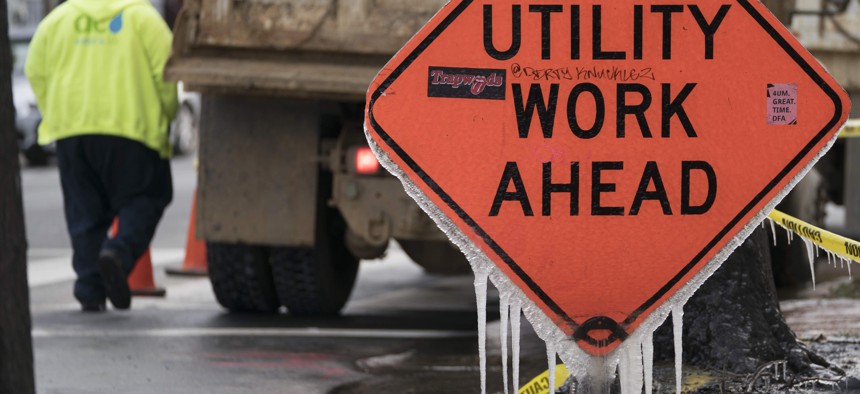The New Federal Spending Bill Is Flush With Money for Waterworks

Water utility workers respond to a ruptured water pipe along Florida Ave. in Northwest Washington, Thursday, Dec. 21, 2017. AP Photo/Andrew Harnik
"The new initiatives and funding increases actually make this legislation a new national water infrastructure program," says a representative for the National Rural Water Association.
WASHINGTON — The massive $1.3 trillion federal spending bill lawmakers in Congress are racing to pass this week would open the spigot for greater federal grants, loans and other assistance to flow to water and wastewater utilities around the U.S.
Programs within the Environmental Protection Agency and the U.S. Department of Agriculture that support water and sewer utilities would see funding levels boosted by hundreds of millions of dollars.
"The new initiatives and funding increases actually make this legislation a new national water infrastructure program," said Mike Keegan, a legislative affairs staffer at the National Rural Water Association. "If the president signs it, he and Congress can claim that."
The so-called omnibus spending legislation lawmakers are forging ahead with covers the rest of fiscal year 2018, which began last Oct. 1. Congress has used temporary measures to keep the government funded since then. On Thursday afternoon, the House passed the omnibus bill, sending it across Capitol Hill to the Senate.
Congress faces a Friday night deadline to approve some sort of spending legislation in order to avoid a partial government shutdown.
This new spending package would allow for more than $3 billion of loans through USDA's rural water and wastewater program, $1.8 billion above the fiscal 2017 level, according to a summary of the legislation from House Appropriations Republicans.
It would also allot nearly $1 billion for grants through the program, up from about $571 million in the last budget cycle.
Funding for what are known as state revolving funds, or SRFs, will also see significant gains if the omnibus bill is enacted as written.
With clean water and drinking water revolving fund programs, the Environmental Protection Agency awards “capitalization grants” to states, and states contribute a 20 percent match.
States then use the funds to provide low-cost loans and other financing assistance for water and wastewater utilities to complete projects. As borrowers repay loans, the principal and interest flows back into the revolving funds and can be used for more lending.
The clean water and the drinking water revolving funds would both get $300 million in extra funding over prior year funding levels in the bill, rising from about $1.4 billion and $863 million respectively.
Tommy Holmes, legislative director for the American Water Works Association,whose members include over 3,900 utilities, applauded additional funding that would go toward the Water Infrastructure and Innovation Act, or WIFIA. This program involves the federal government lending directly for water projects at interest rates aligned with the typically low rates for U.S. Treasury debt.
Eligible borrowers include states, localities, corporations, and joint ventures—although private entities need a public sponsor to access the program. Beyond low interest rates, WIFIA borrowers stand to benefit from perks that have to do with the timeframe for repaying loans.
WIFIA received $30 million in total funding in fiscal 2017, Holmes noted. With the omnibus it would get $63 million.
"We are very pleased in the confidence that Congress has expressed in the WIFIA program," Holmes said in an email on Thursday. "This additional appropriation should open up the program for a significantly larger number of utilities and state agencies."
An estimated $1 trillion is necessary to maintain and expand drinking water service during the next 25 years, according to figures cited by the American Society of Civil Engineers. The dollar amount required for wastewater infrastructure upkeep over the next two decades is somewhere in the ballpark of $271 billion, the group also says.
As Route Fifty has reported, some rural communities with sparse populations and aging infrastructure have an especially difficult time maintaining pipes, water storage and treatment facilities. Loan and grant programs like those available through USDA have proven to be key sources of funding for upgrades in these places.
Last month, the Trump administration rolled out an infrastructure plan that calls for about $200 billion of new federal spending on public works, mostly through a suite of new grant programs. Funding in the spending bill would not go to the grant programs the president has proposed and would instead get funneled into existing accounts.
The National Rural Water Association is supportive of allocating money to existing programs, according to Keegan, particularly those designed to target communities with the greatest needs.
Keegan also flagged a number of smaller-sized spending provisions related to water utilities embedded in the omnibus.
These include funding for various technical assistance and training programs, including one he said doubled to $40 million. Securing technical assistance funding has been a priority for NRWA.
The bill also includes $20 million for EPA to use for water infrastructure grants for small and disadvantaged communities. And another $20 million for a grant program to support voluntary testing for lead contamination in the drinking water at schools and child care facilities. The money for both programs is new, Keegan said.
A two-year budget deal lawmakers reached last month is providing a framework for the omnibus. It relaxed longstanding budget caps and cleared the way for boosted spending across a wide variety of programs. But estimates show the deal, if adhered to, would also deepen federal budget deficits in the coming years.
PREVIOUSLY on Route Fifty:
Bill Lucia is a Senior Reporter for Government Executive's Route Fifty and is based in Washington, D.C.
NEXT STORY: Use Trump’s Infrastructure Package to Fix Our Past Infrastructure Sins






